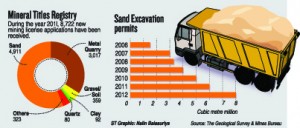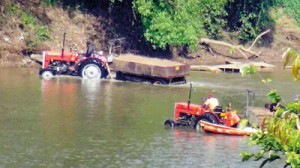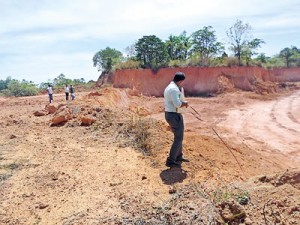News
Building boom endangers sand and gravel resources
 Sri Lanka’s lawmakers this week approved a proper mechanism to mine sand, gravel, and rocks from lands belonging to the Mahaweli Authority and Forest Department where applicable. The decision aims to ease the demand for these and other building materials.
Sri Lanka’s lawmakers this week approved a proper mechanism to mine sand, gravel, and rocks from lands belonging to the Mahaweli Authority and Forest Department where applicable. The decision aims to ease the demand for these and other building materials.
A cabinet paper states that only lands that are not declared as ‘protected areas’ will be targeted and that mining be done only after an environmental assessment. But environmentalists say the remaining forests should not be vandalized.
The Environment Conservation Trust’s Sajeewa Chamikara says that as soon as the war ended, forests in the north were mined for soil, gravel, and rocks to provide materials for infrastructure such as roads. “This eventually led to a severe water shortage in some of the northern areas and the new approval of mining in forest areas could also lead to such a situation,” he warns.
Environmentalist Nayanaka Ranwella, points out the situation is worse in the Gampaha District in the Western Province. “There are a lot of mining activities as these building materials could be easily transported to Colombo due to the proximity. But these mines already contribute to water shortages in the area,” he said. He also says there are no licences for 80 per cent of the excavations. Even those who have licences excavate more than what is allowed.
Geological Survey and Mines Bureau Acting Director General, Sajjana De Silva, said the agency had cancelled more than 100 licences citing violation of conditions during the past few years. He said there are a number of unapproved excavations and that support from other agencies is needed.
He said the daily volumes needed to fill the central expressway exceeds the amount of gravel generated by all licencees.But as controls are tightened, it is creating shortages of building materials.Projects such as expressways and numerous high-rises in Colombo and elsewhere require massive amounts of natural materials.Experts says there is a construction boom in Sri Lanka.

Sand mining at Dambulla
“Finding sand and other materials is the worst headache for contractors,” says the Chairman of National Construction Association of Sri Lanka, Athula Galagoda. He also says that the quality of the sand is poor.
Road Development Authority Chairman, Nihal Suriarachchi also says sourcing gravel for filling purposes is diffcult and it could affect expressway projects.
Sajeewa Chamikara of the Environment Conservation Trust suggests estimating the materials requirements and identifying ways of sourcing before projects are started.

Sand mining at Divulapitiya
GSMB’s former chairman, Dr. N. P. Wijayananda, points out that most of the problems regarding gravel occur because the constructors or suppliers of soil and other material are looking for sources closer to construction sites. It will be cheaper to transport, but will carry a huge environmental cost.
“Find a feasible source of gravel in a central place, do the mining scientifically and transport to the construction site. Yes, the supplier will have to spend more for transport, but environmental damage will be much less,” Dr Wijayananda suggests.
The SundayTimes also asked Dr Wijayananda, what could be a possible solution. He suggests a three-pronged approach – opening up new deposits, using railways to reduce transport costs, and promote the use of sea sand.
He recalled that earlier the sand deposits at Manampitiya were opened up to meet urgent needs.
“The flow of the Mahaweli river causes sand to accumulate around the Manampitiya Bridge in Polonnaruwa, creating a flood plain around it. If we do not use this sand, they will anyway be washed to the sea. The next monsoon will replenish the sand deposits, so sand excavation in this area could be done sustainably,” Dr Wijayananda assures.
He reveals there are other sand deposits between Manampitiya and Trincomalee. But there are no proper access roads and it is not easy to transport from the sites.
“All these excavations have to be done under strict guidelines without deepening the river unnecessarily and without affecting the banks,” Dr Wijayananda said.
He also said that during his tenure at the Mines Bureau discussions were held with the railways on transporting materials, but that it was more expensive. “But if the government is willing, it can amend the rules facilitating cheaper sea sand transport by rail. I’m sure the cost of sand can be reduced by 40 percent,” he said.
Sea sand needs to be properly cleaned. “Europe extensively use sea sand for construction. We need to mechanically clean the sea sand and set standards of minimum salinity levels.”

